Speckled Dace
-
Scientific NameRhinichthys osculus
-
NativeNative Species
-
Identification
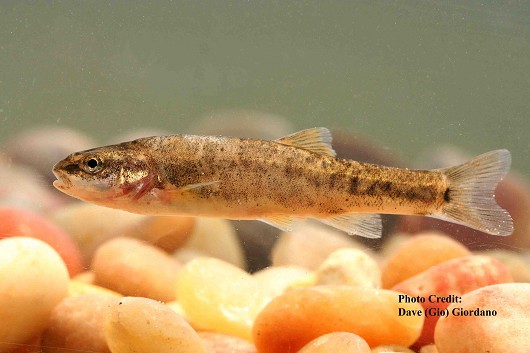 Speckled dace, approximately 7 cm (3”) long. Date: 7/8/2007.
Speckled dace, approximately 7 cm (3”) long. Date: 7/8/2007.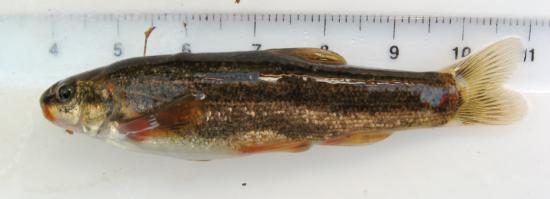 Speckled dace, caught in Bogard Spring Creek (Eagle Lake watershed) in 2011. Photo by Teejay O'Rear. Scale in cm.
Speckled dace, caught in Bogard Spring Creek (Eagle Lake watershed) in 2011. Photo by Teejay O'Rear. Scale in cm.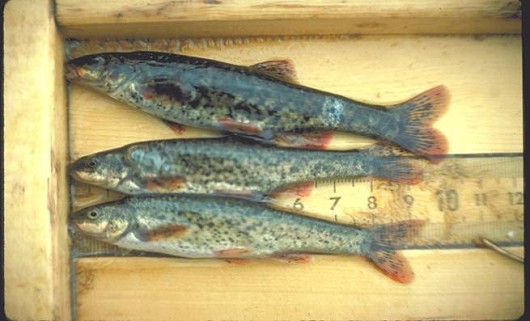 Speckled dace, adults. Photo courtesy of Professor Peter B. Moyle. Note: scale is in cm.
Speckled dace, adults. Photo courtesy of Professor Peter B. Moyle. Note: scale is in cm.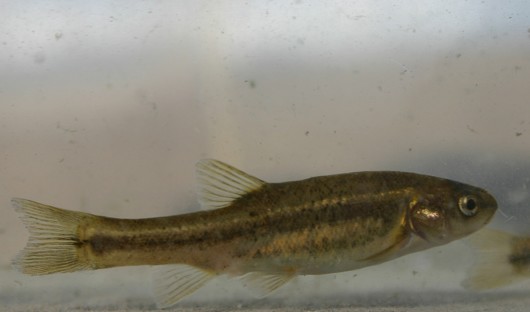 Speckled dace (Owens speckled dace). Location: Fish Slough, CA. Photo by Joe Ferreira, California Department of Fish and Game.
Speckled dace (Owens speckled dace). Location: Fish Slough, CA. Photo by Joe Ferreira, California Department of Fish and Game.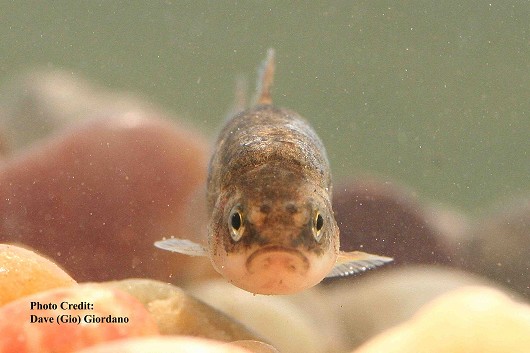 Speckled dace, approximately 7 cm (3”) long, frontal view. Date: 7/8/2007.
Speckled dace, approximately 7 cm (3”) long, frontal view. Date: 7/8/2007.- Small fish: usually less than 8 cm, sometimes more than 11 cm
- Usually 1 barbel at the end of each jaw, and a frenum or flap of skin attaching snout to upper lip
- Back and sides are dusky yellow or olive,covered with dark speckles and splotches
- Bases of fins turn red in both sexes during breeding time, and males often get red snout and lips
- Fin rays: dorsal 6-9 ( usually located behind pelvic fins), anal 6-8
-
Life History
Speckled dace are capable of living in an array of habitats from small springs or streams to large rivers and deep lakes. Speckled dace prefer habitat that includes clear, well oxygenated water, with movement due to a current or waves. In addition the fish thrive in areas with deep cover or overhead protection from vegetation or woody debris. Speckled dace predominantly occupy small streams of the second to third order where they feed and forage for aquatic insects. The species is very adaptable and is found in cold alpine lakes such as Lake Tahoe, but has also been able to survive adversity in temperatures at or above 31°C with a dissolved oxygen concentration of 1 mg/L. In streams speckled dace swim along the bottom looking for small invertebrates while in lakes they are opportunistic feeders that may feed on zooplankton, algae, nymphs, or the resulting flying insects. Speckled dace typically have a life span of three years, but may live 6 or more years, during which time females typically grow more rapidly than males. The fish become sexually mature in their second year and during the summer months the dace spawn. Stream dwellers spawn in riffles or gravely areas, while the lake inhabitants spawn in tributaries or in shallow shoreline regions. The embryos hatch in 6 days, and the larvae remain in the safety of the gravel for 7-8 days. The young fry then spend the early part of their lives in the shallow warm areas of the stream or lake where they hatched.
-
Links to Other ResearchN / A
-
Watershed
-
Alisal-Elkhorn Sloughs Watershed
-
Antelope-Fremont Valleys Watershed
-
Butte Watershed
-
Central Coastal Watershed
-
Cottonwood Headwaters Watershed
-
Coyote Watershed
-
Crowley Lake Watershed
-
Cuyama Watershed
-
Death Valley-Lower Amargosa Watershed
-
East Branch North Fork Feather Watershed
-
East Walker Watershed
-
Estrella Watershed
-
Eureka-Saline Valleys Watershed
-
Fish Lake-Soda Spring Valleys Watershed
-
Goose Lake Watershed
-
Honcut Headwaters Watershed
-
Honey-Eagle Lakes Watershed
-
Lake Tahoe Watershed
-
Los Angeles Watershed
-
Lost Watershed
-
Lower American Watershed
-
Lower Bear Watershed
-
Lower Butte
-
Lower Cache Watershed
-
Lower Cosumnes-Lower Mokelumne Watershed
-
Lower Cottonwood Watershed
-
Lower Feather Watershed
-
Lower Klamath Watershed
-
Lower Pit Watershed
-
Lower Sacramento Watershed
-
Lower Yuba Watershed
-
Madeline Plains Watershed
-
Middle Fork Eel Watershed
-
Middle Fork Feather Watershed
-
Mill-Big Chico Watershed
-
Mojave Watershed
-
Mono Lake Watershed
-
North Fork American Watershed
-
North Fork Feather Watershed
-
Owens Lake Watershed
-
Pajaro Watershed
-
Sacramento Headwaters Watershed
-
Sacramento-Lower Cow-Lower Clear Watershed
-
Sacramento-Lower Thomes Watershed
-
Sacramento-Stone Corral Watershed
-
Sacramento-Upper Clear Watershed
-
Salinas Watershed
-
Salmon Watershed
-
Salton Sea Watershed
-
San Antonio Watershed
-
San Gabriel Watershed
-
San Jacinto Watershed
-
Santa Ana Watershed
-
Santa Clara Watershed
-
Santa Maria Watershed
-
Santa Monica Bay Watershed
-
Santa Ynez Watershed
-
Scott Watershed
-
Shasta Watershed
-
Smoke Creek Desert Watershed
-
South Fork American Watershed
-
South Fork Trinity Watershed
-
Surprise Valley Watershed
-
Trinity Watershed
-
Truckee Watershed
-
Upper Amargosa Watershed
-
Upper Bear Watershed
-
Upper Butte
-
Upper Cache Watershed
-
Upper Carson Watershed
-
Upper Coon-Upper Auburn Watershed
-
Upper Cosumnes Watershed
-
Upper Cow-Battle Watershed
-
Upper Elder-Upper Thomes Watershed
-
Upper Klamath Watershed
-
Upper Mokelumne Watershed
-
Upper Pit Watershed
-
Upper Putah Watershed
-
Upper Yuba Watershed
-
Warner Lakes Watershed
-
West Walker Watershed
-
Please note, watersheds are at the USGS 8-digit Hydrologic Unit Code (HUC) scale, so they often include a lot of sub-watersheds. If a species occurs in any sub-watershed within the HUC, the species appears within the HUC. Link to an EPA page that shows HUCs.




